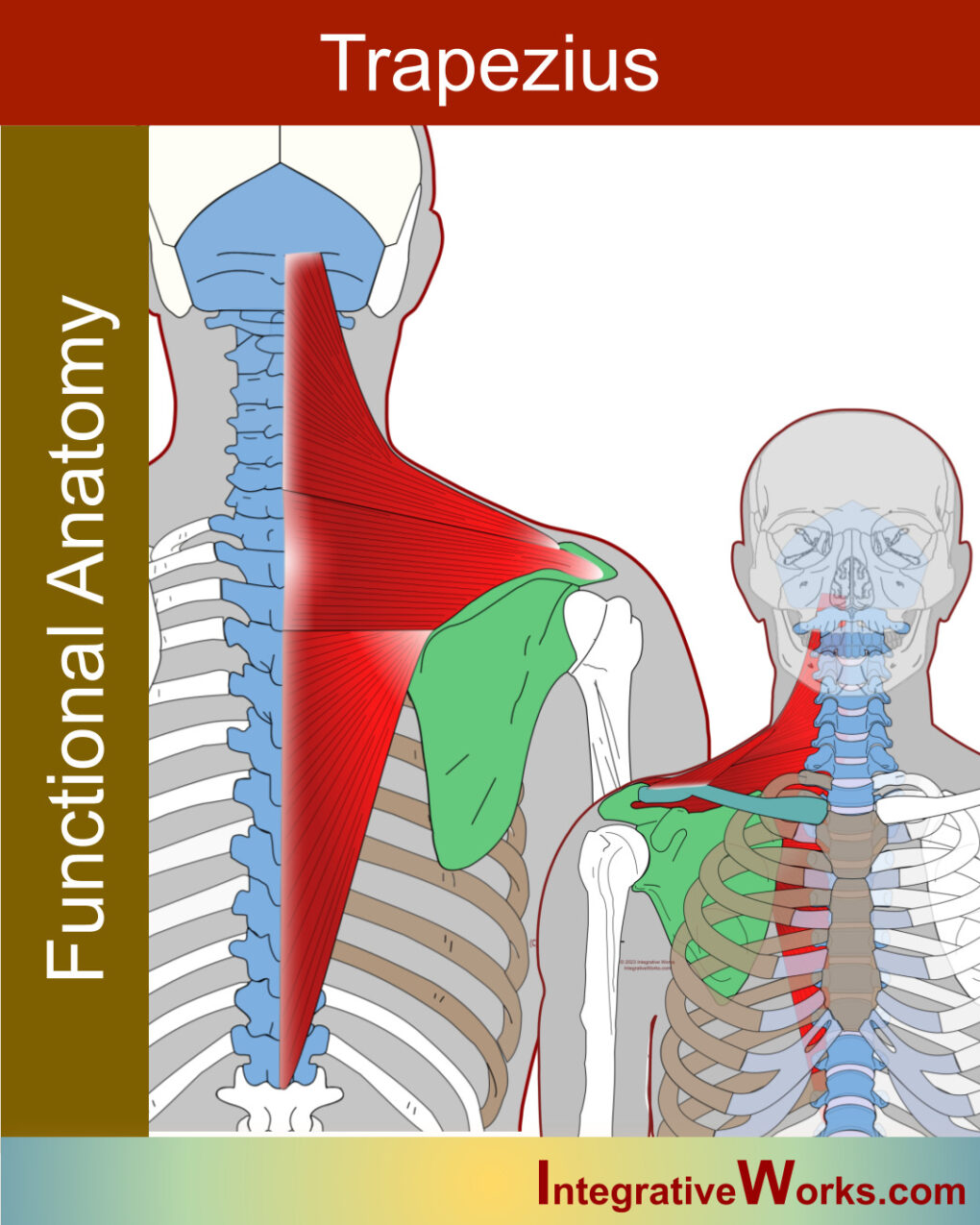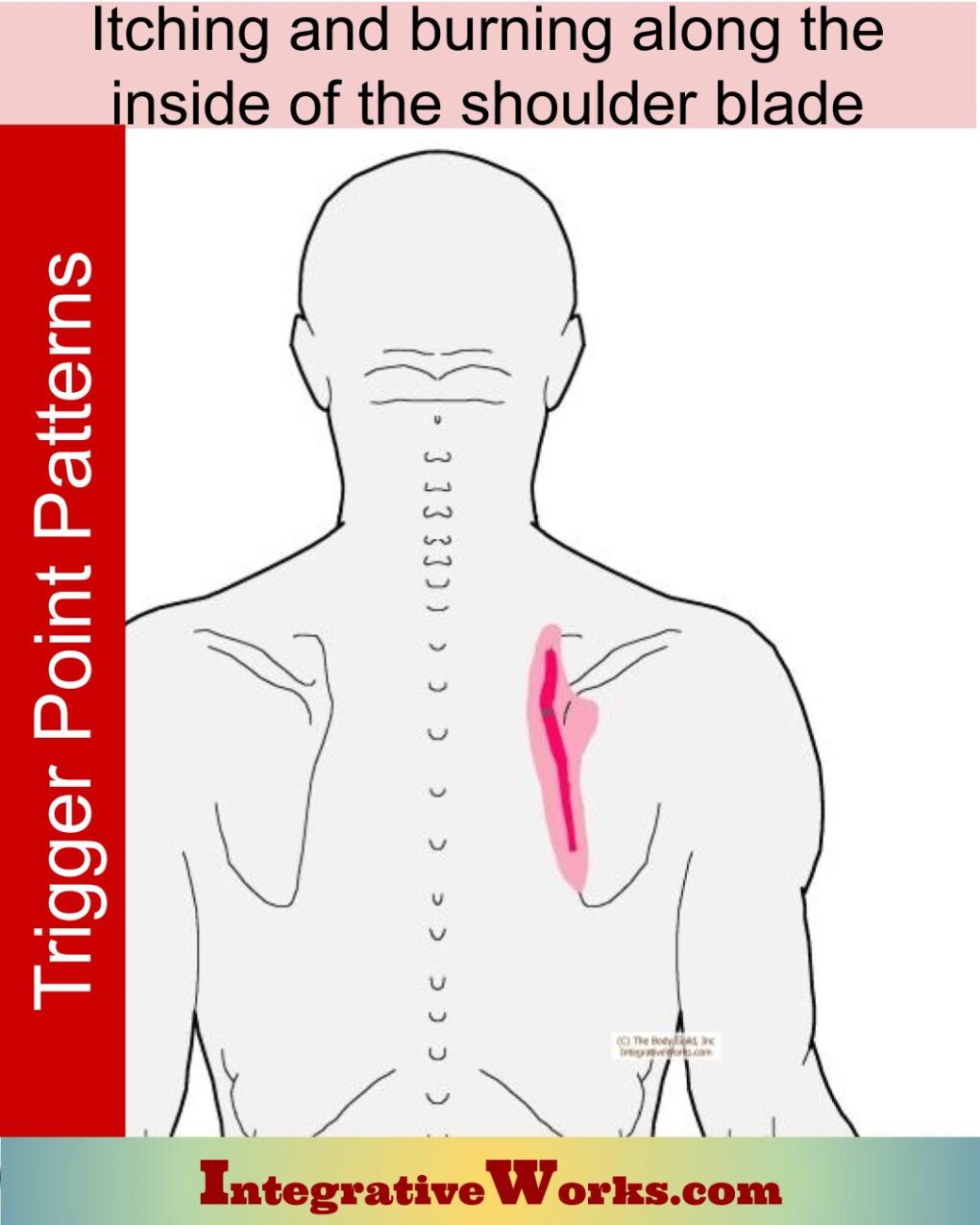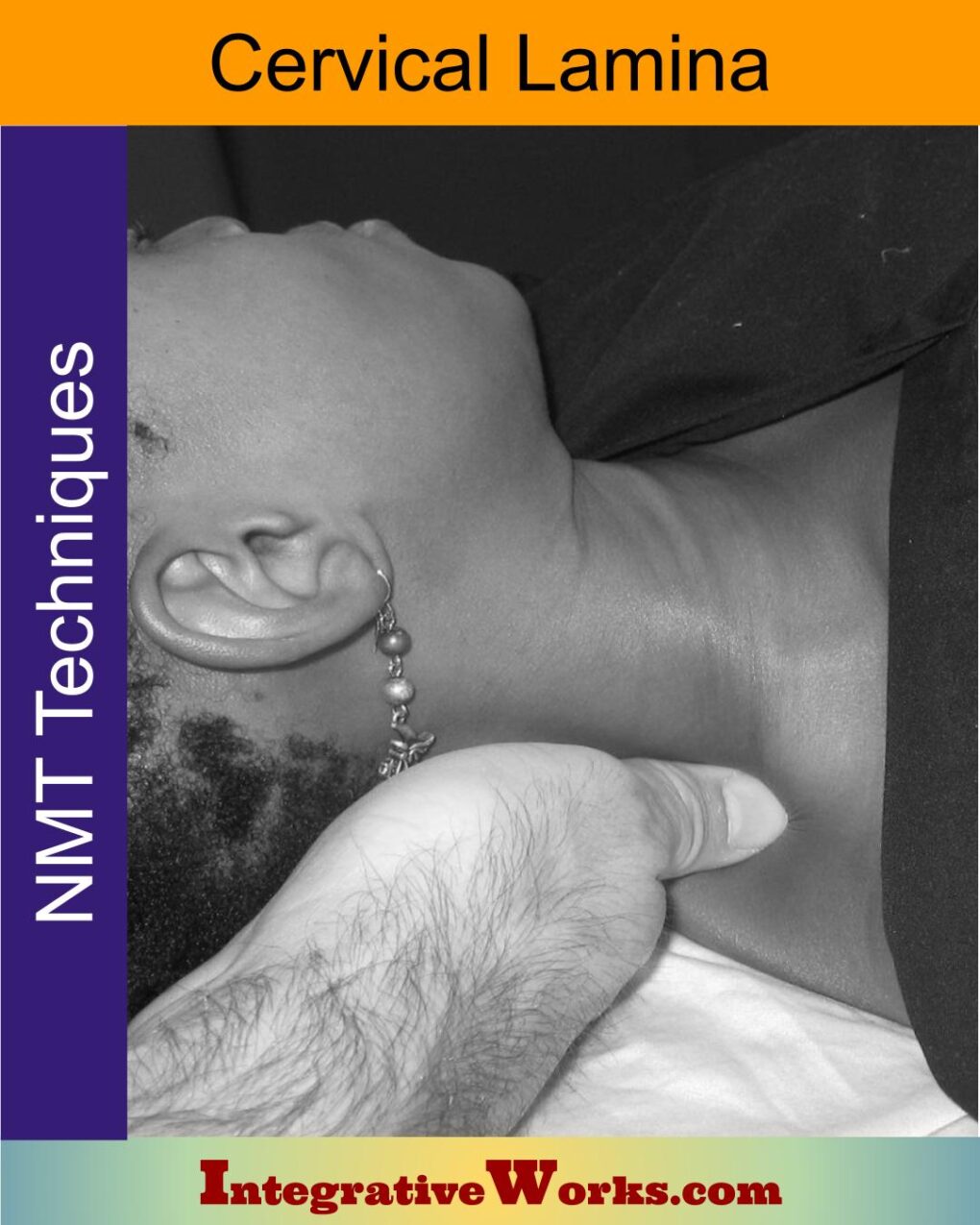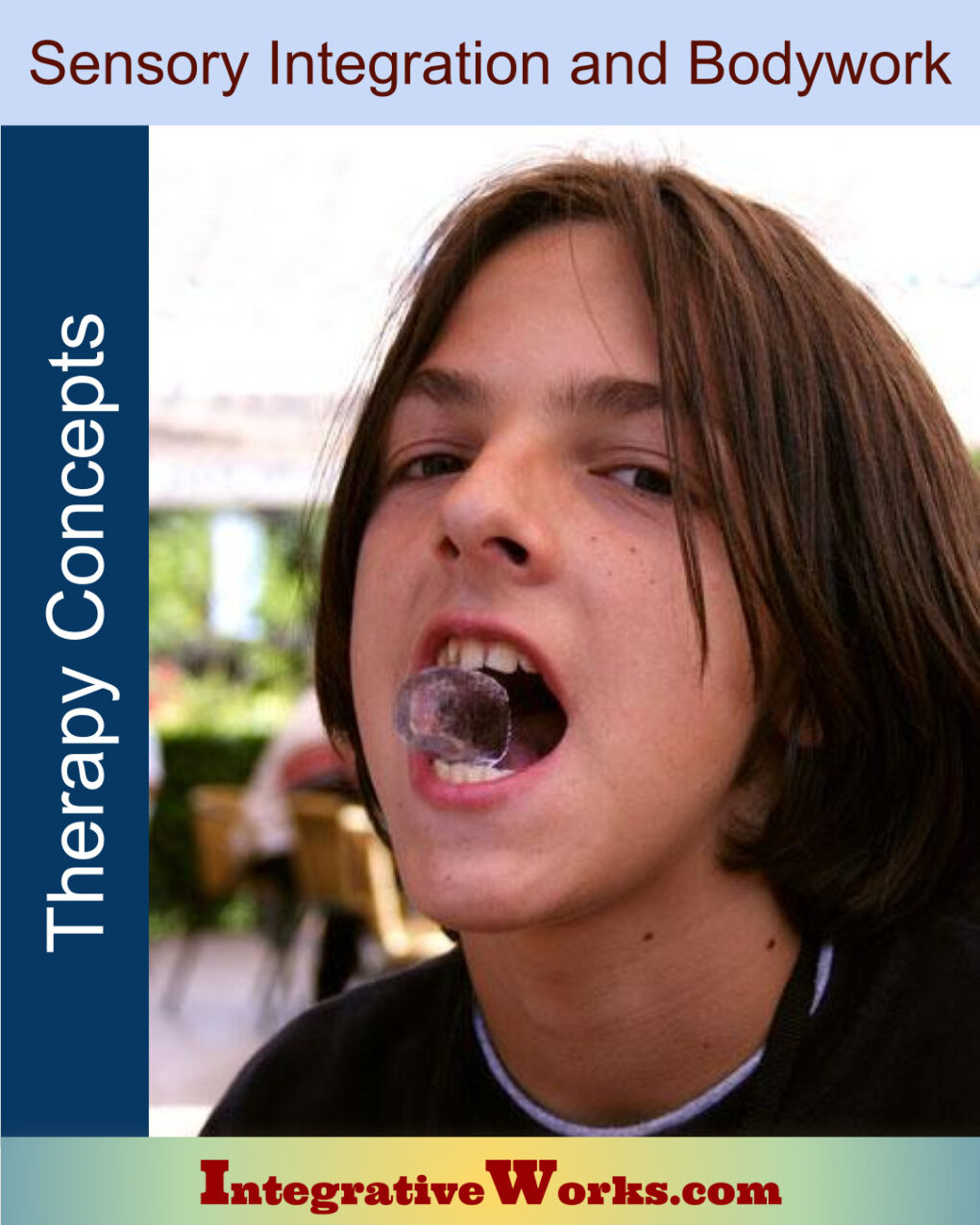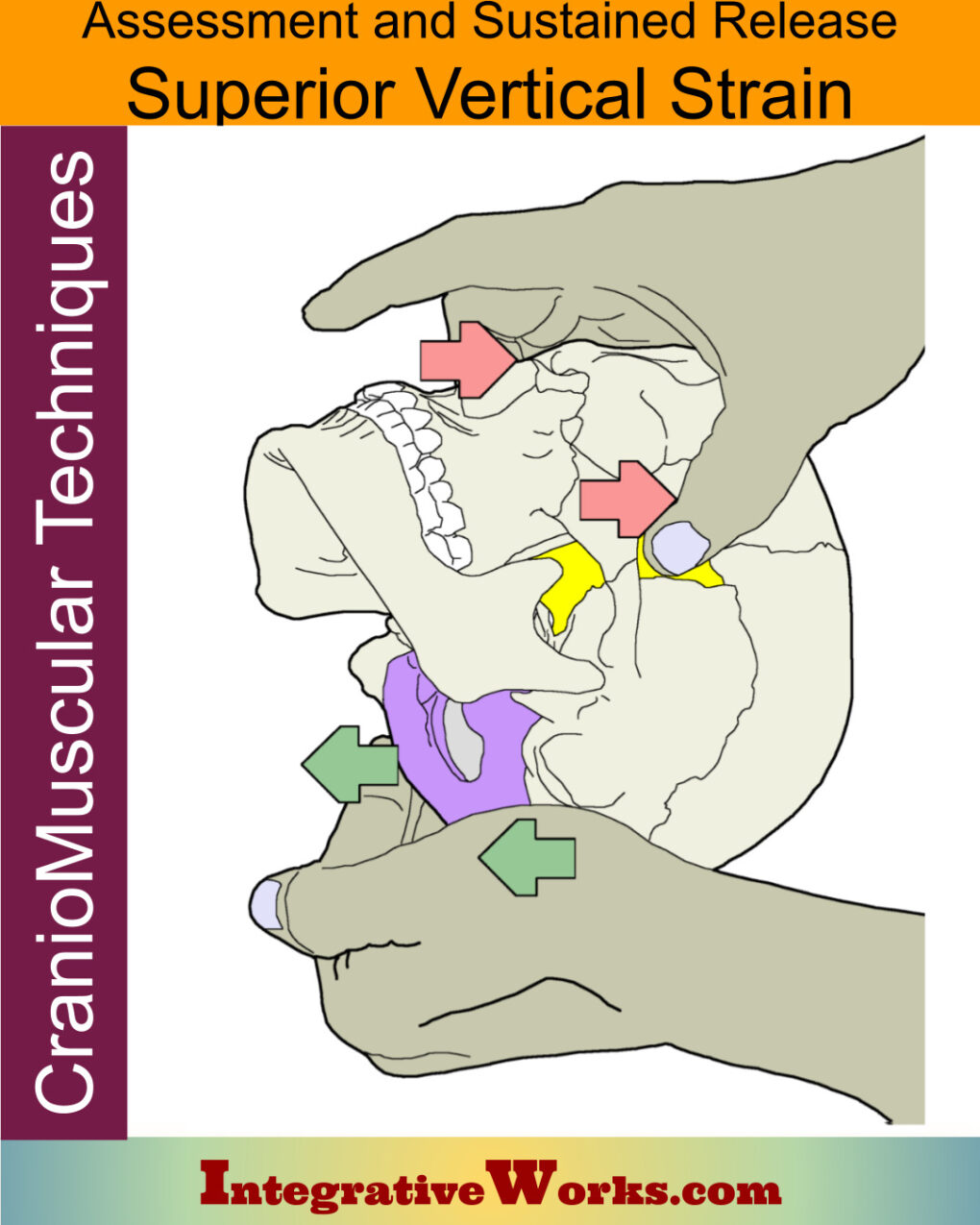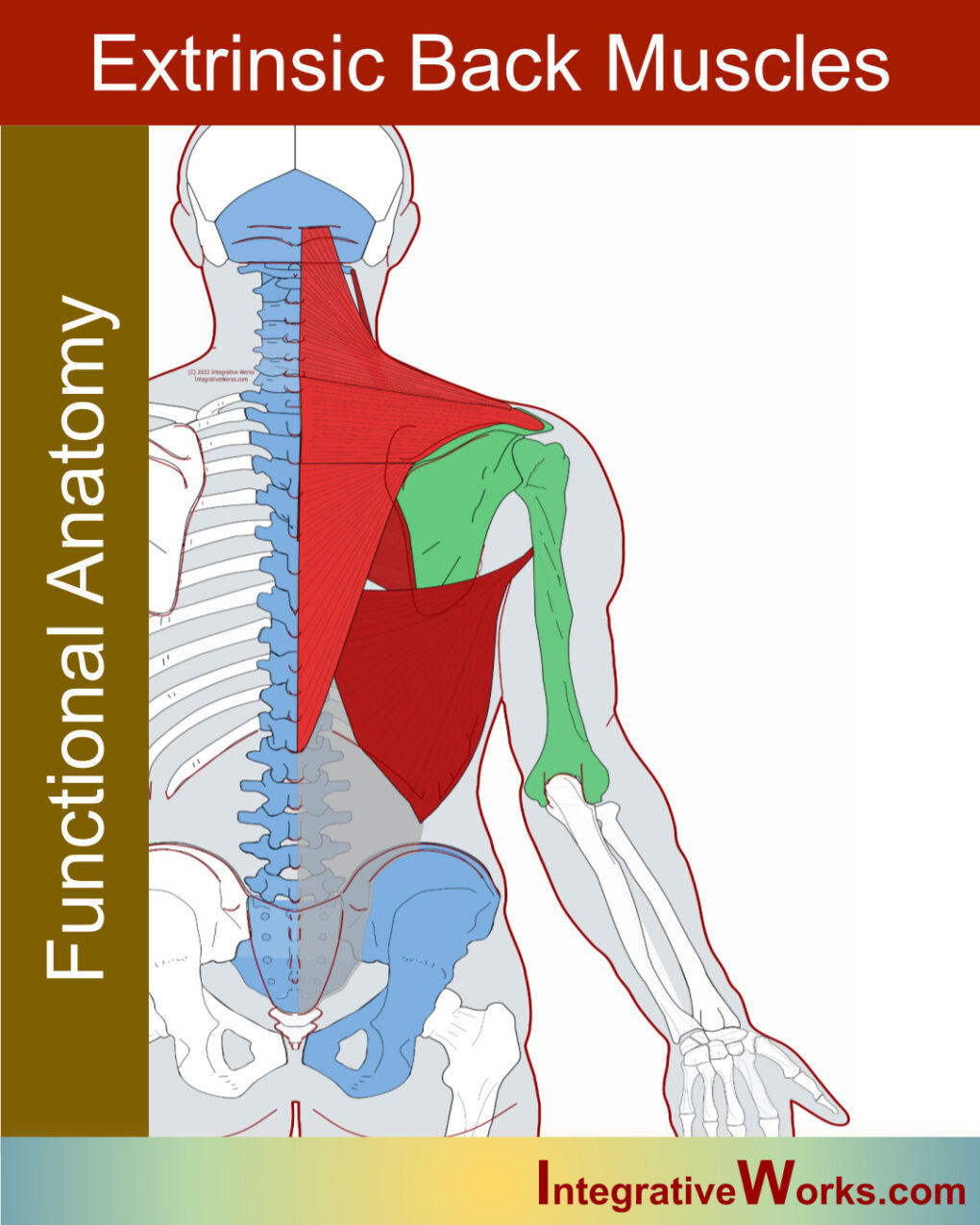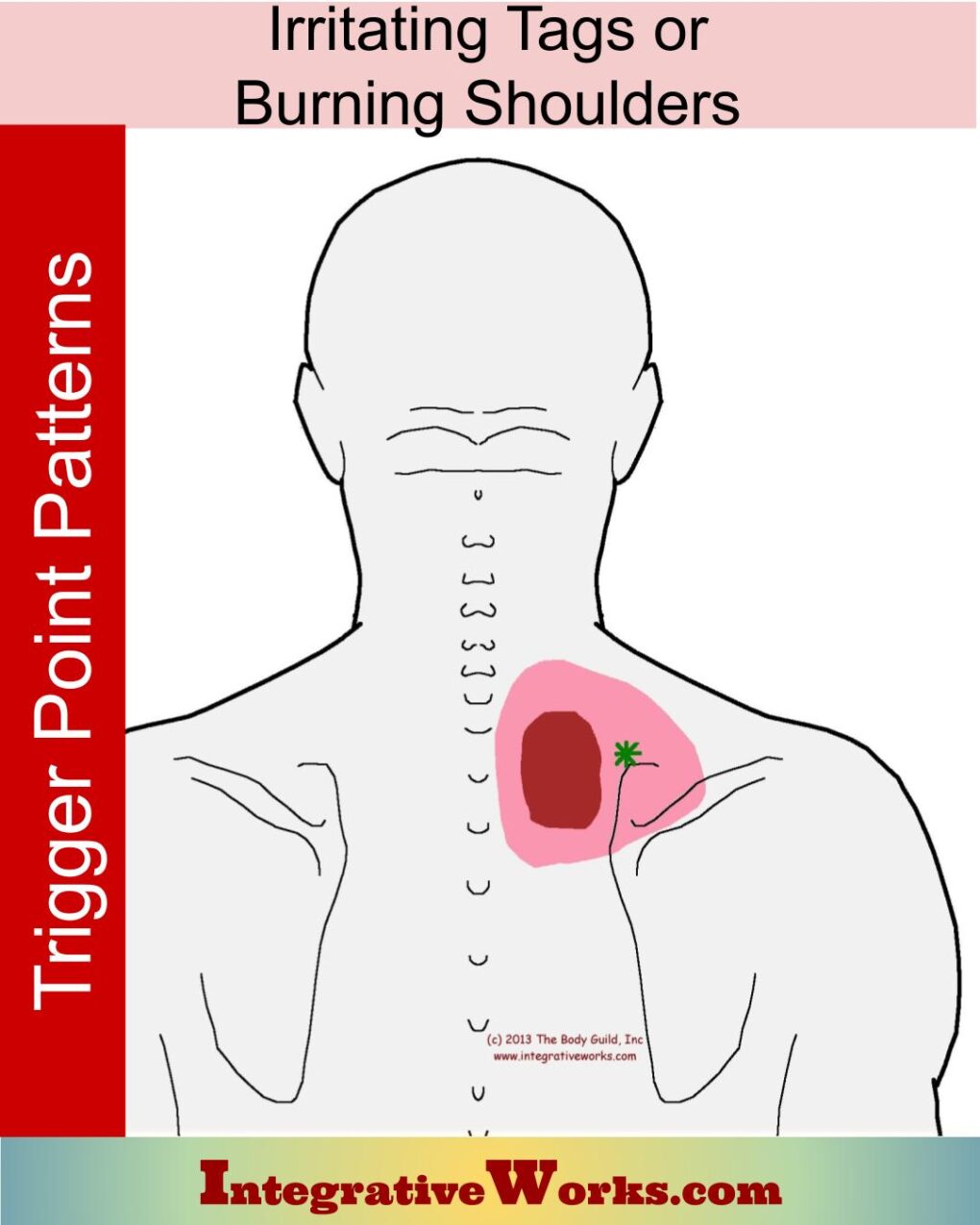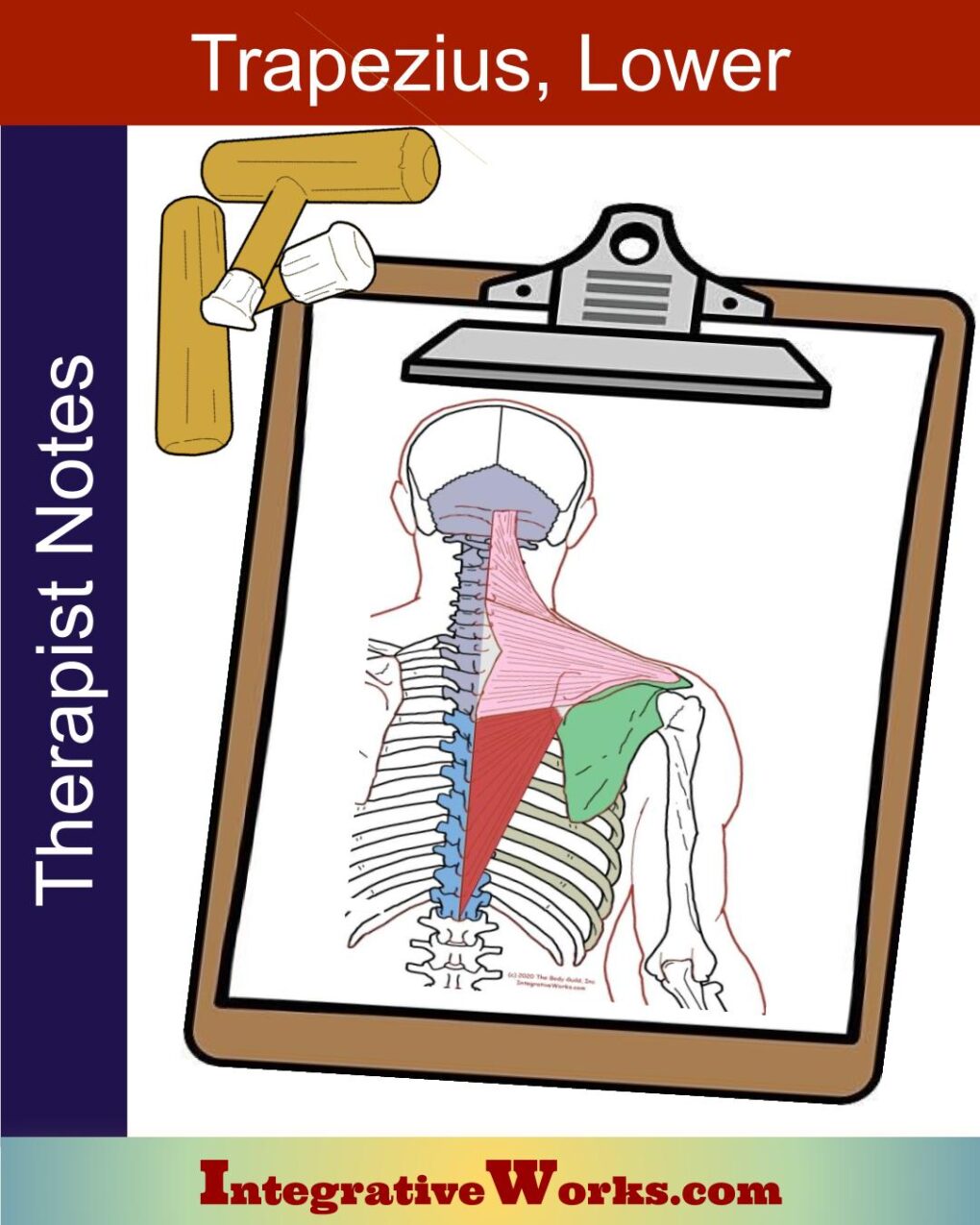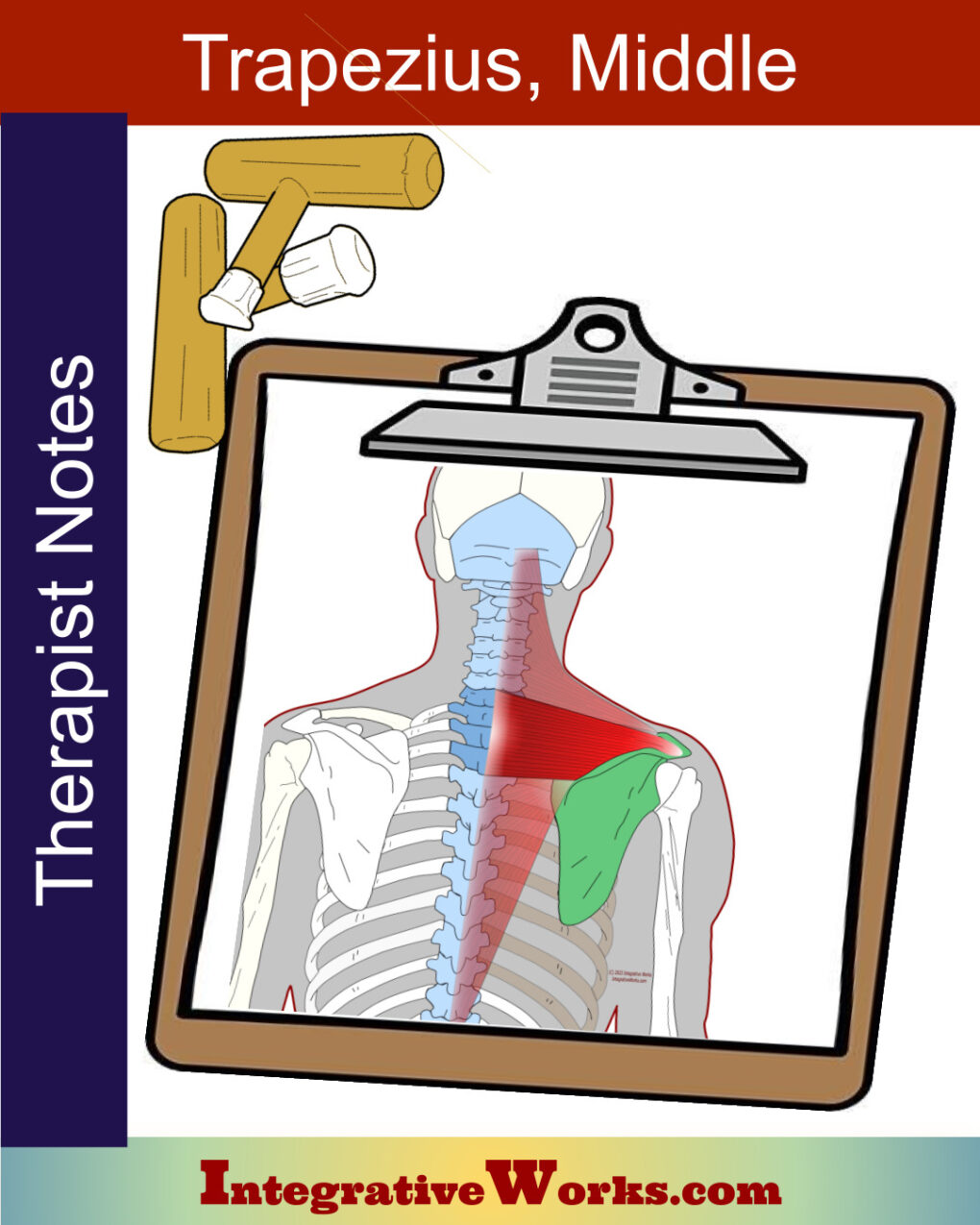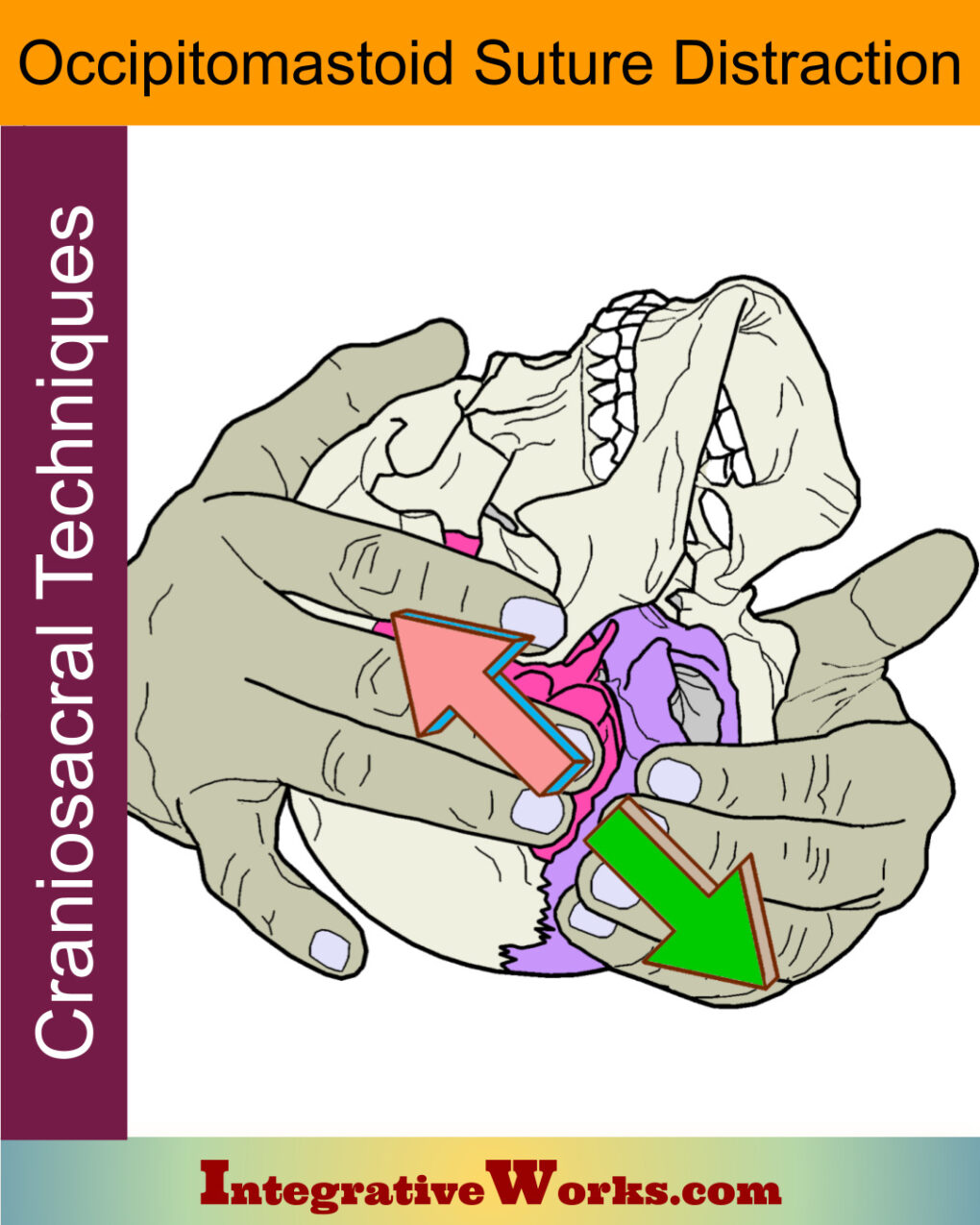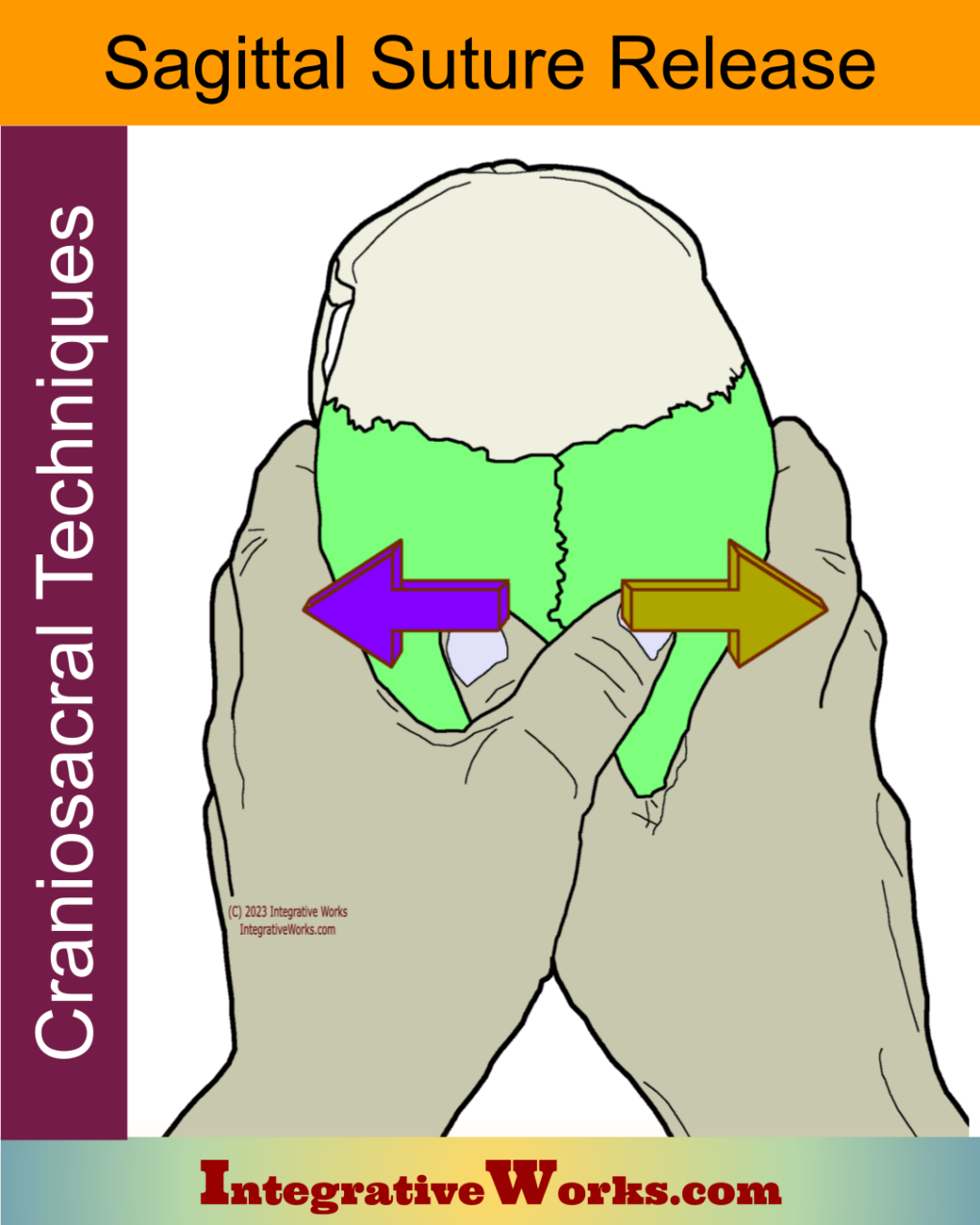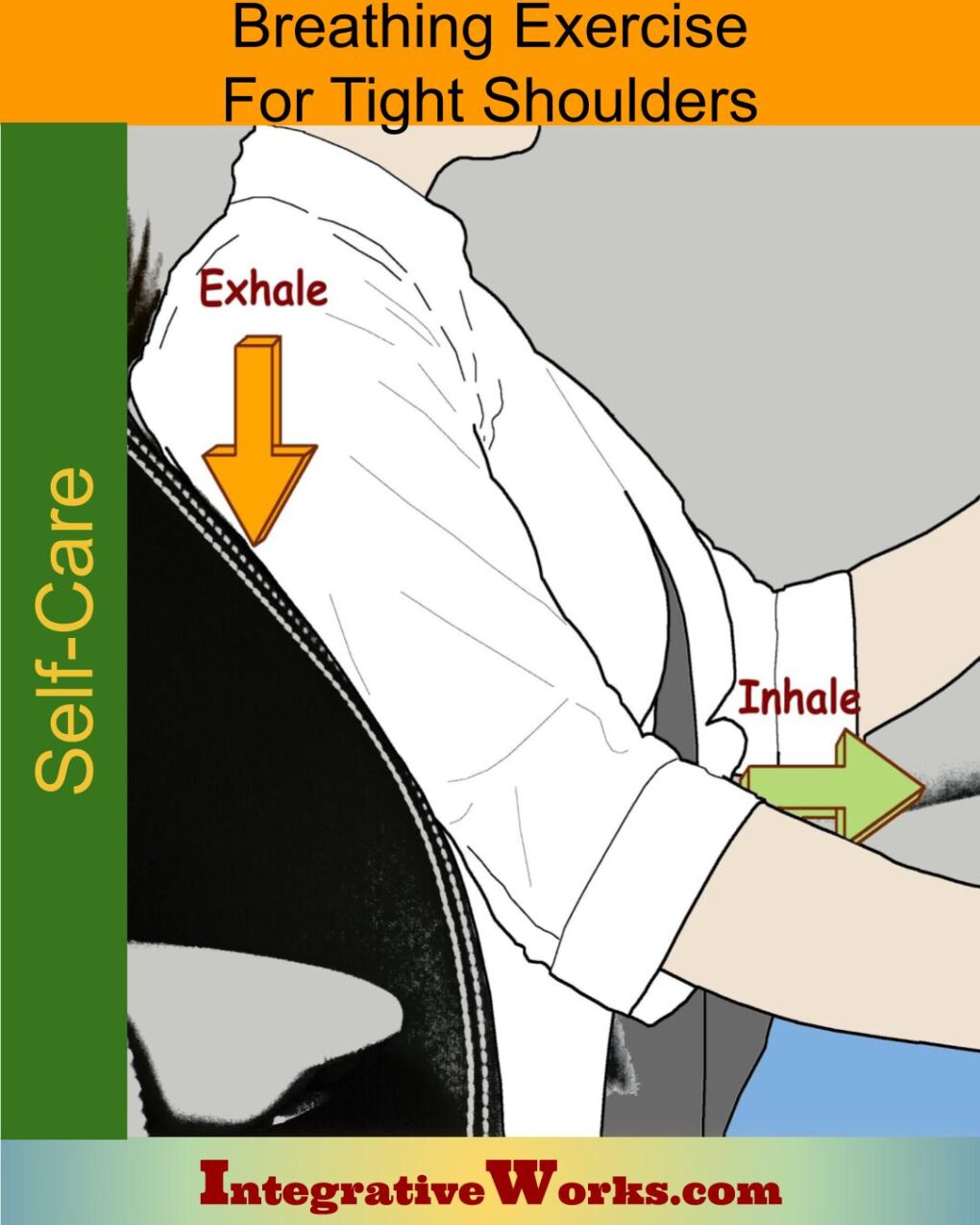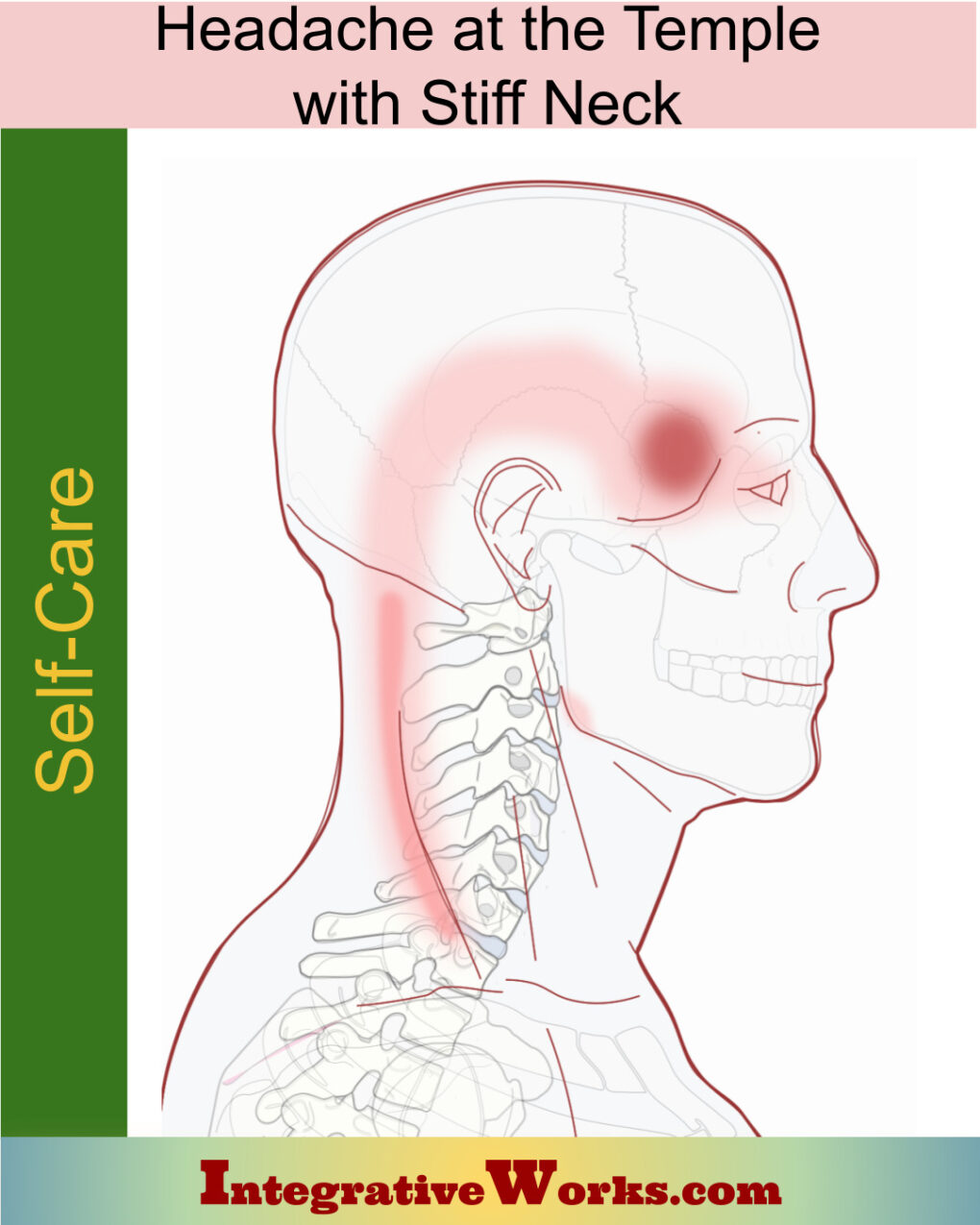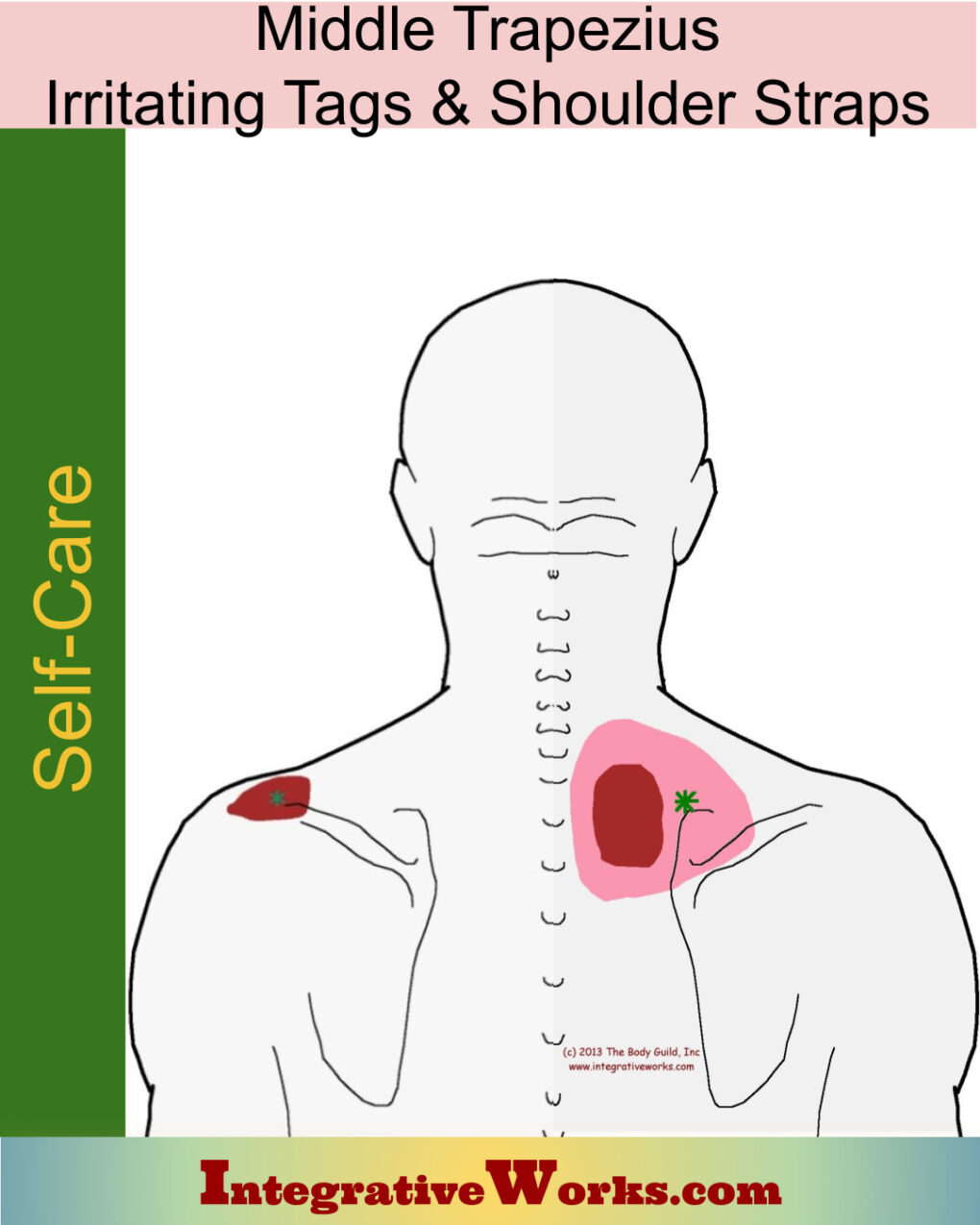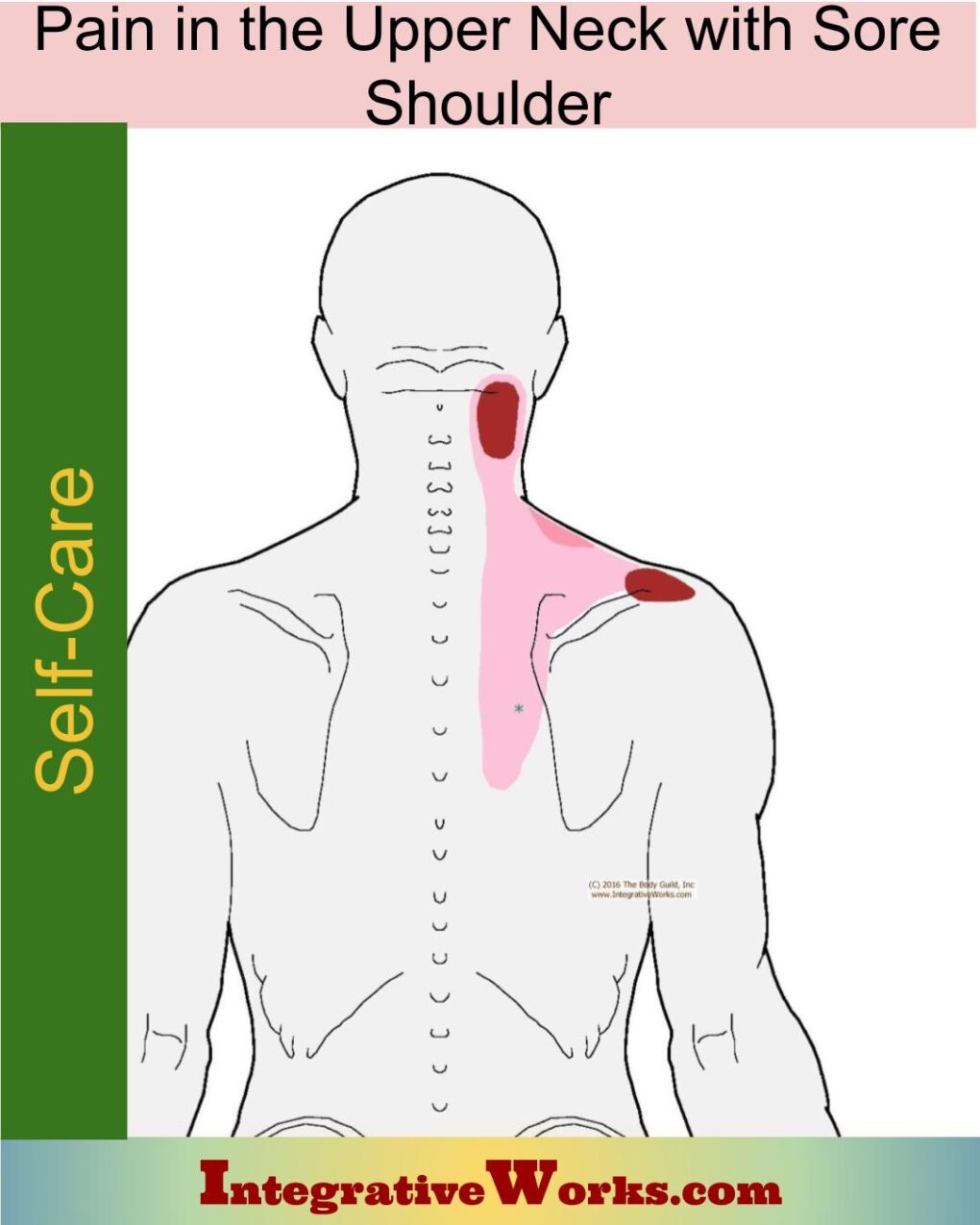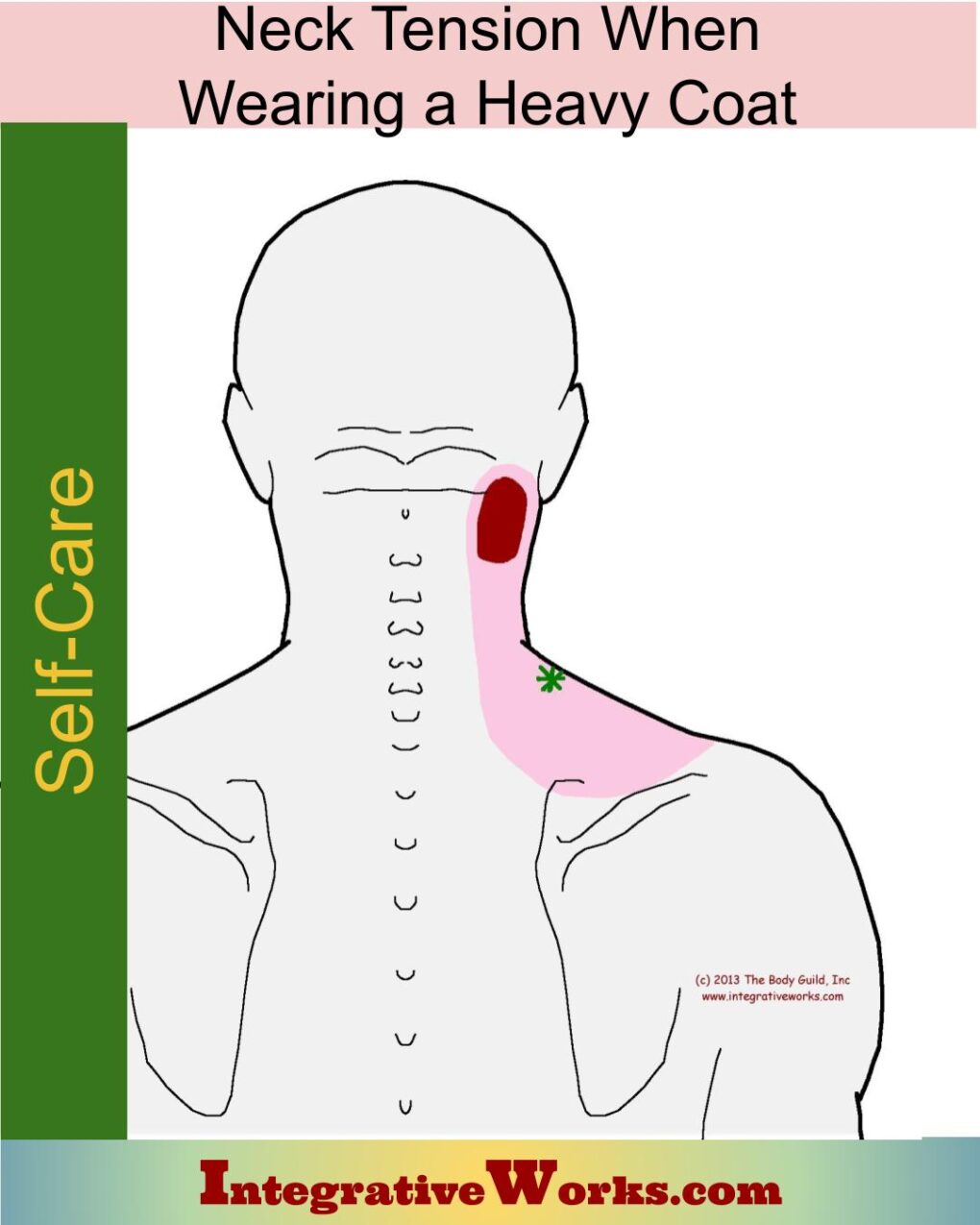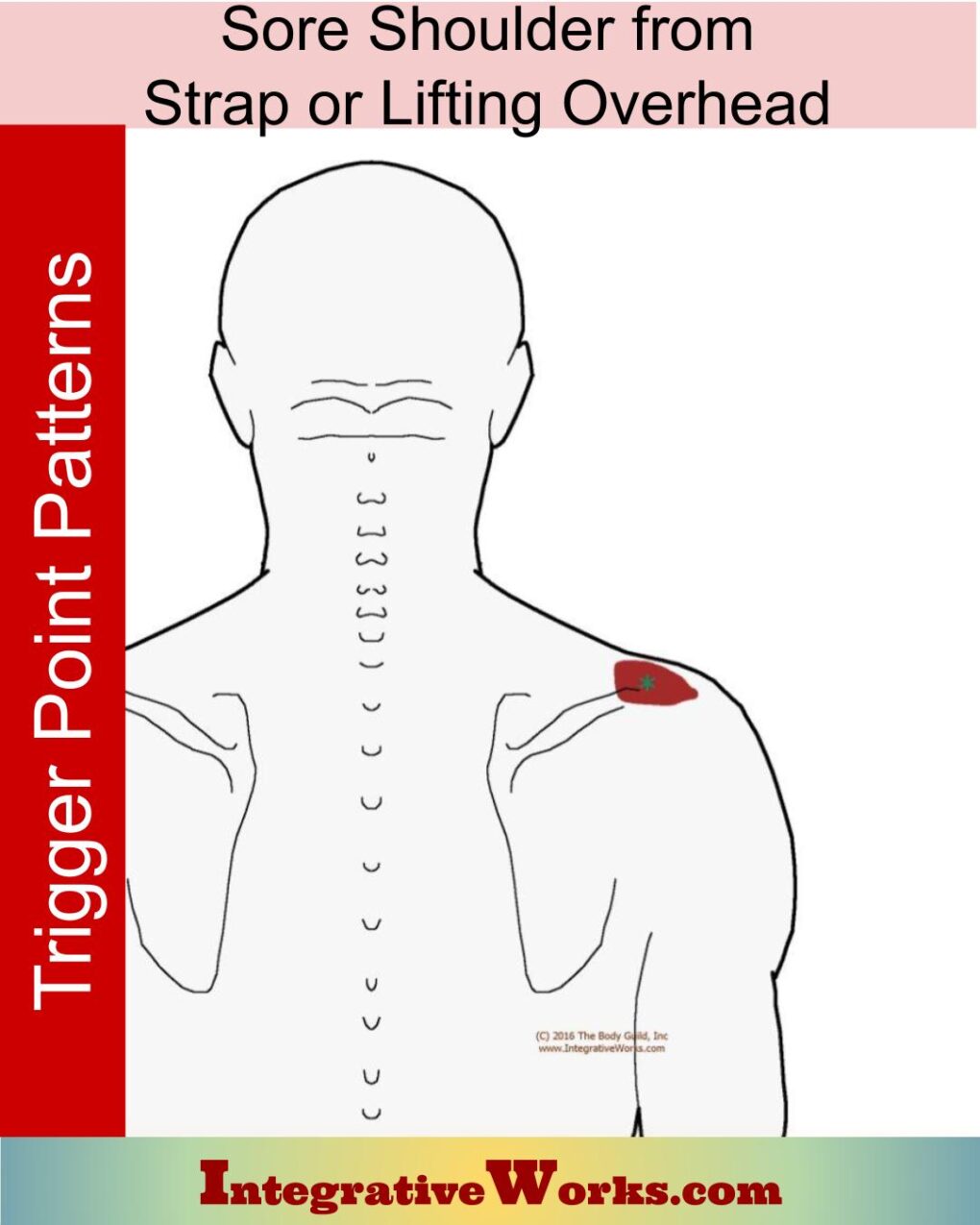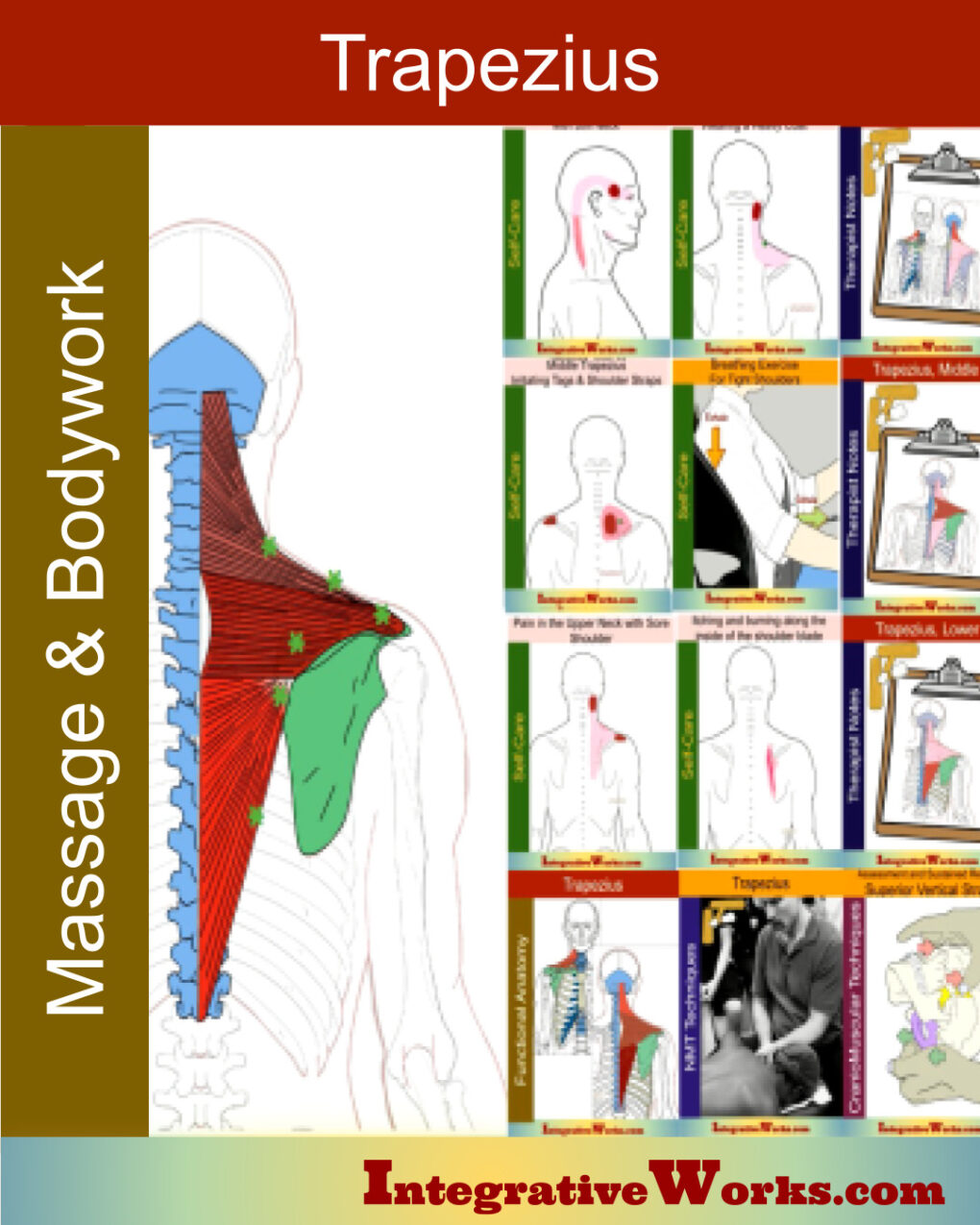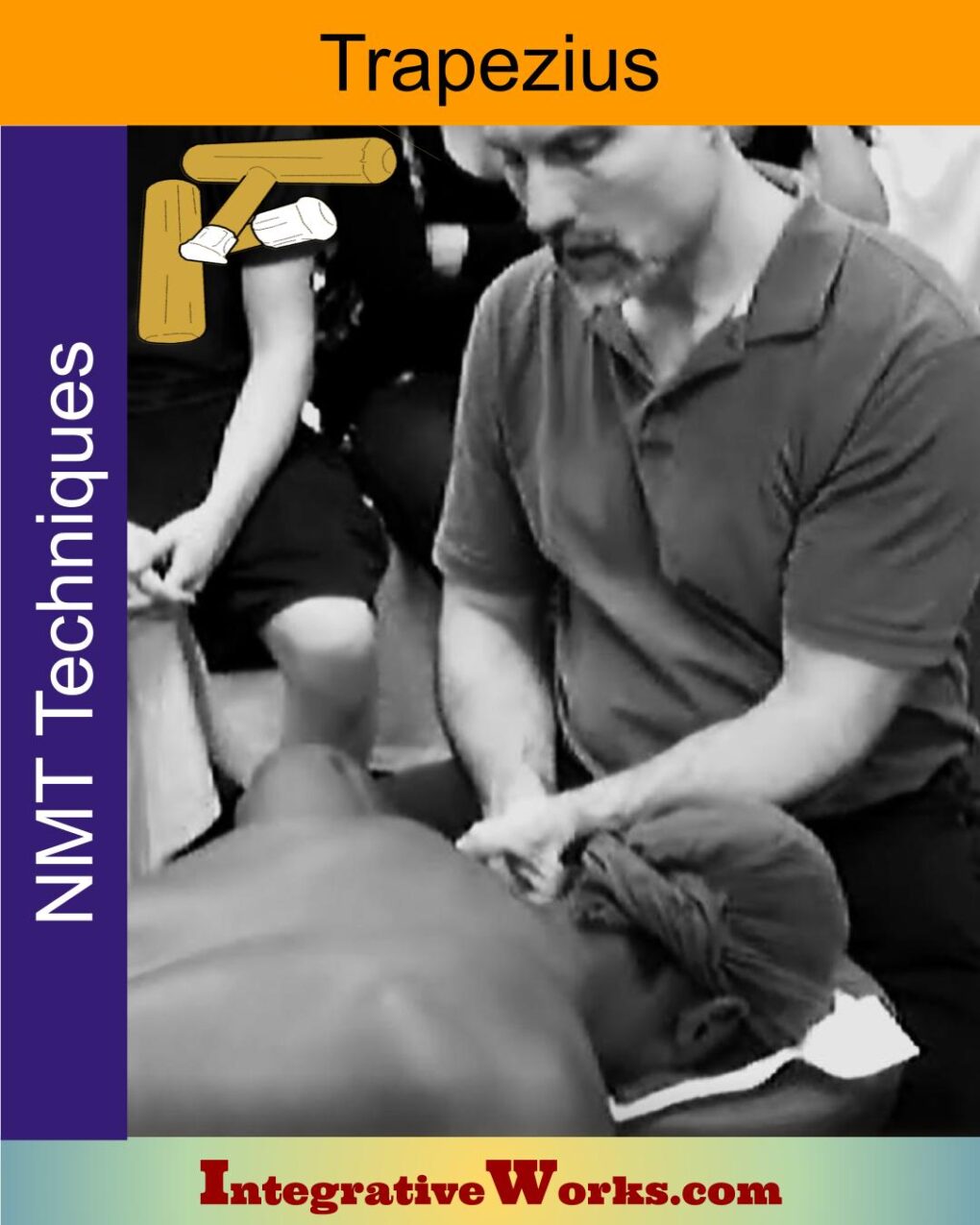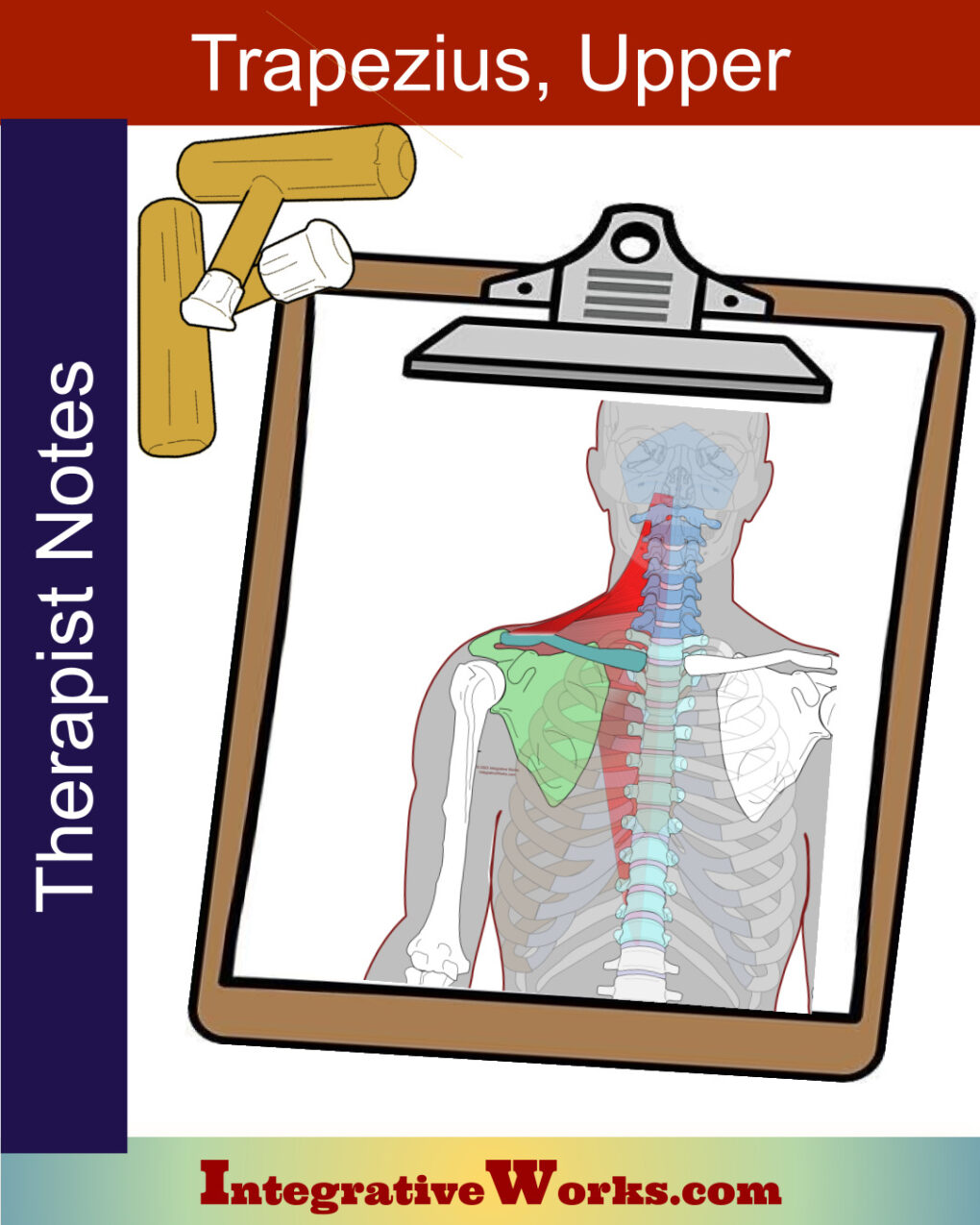Overview
Trapezius anatomy is complex. The trapezius is a broad, flat muscle covering the upper back. It is named for the trapezoid shape that these paired muscles create. It has three major sections that originate on the axial skeleton and insert on the pectoral girdle, making it an extrinsic back muscle.
Each of its sections has a distinctive function and its own pain patterns. The upper section is similar in attachment, function, and referral patterns to the sternocleidomastoid. The middle and lower sections are similar to each other in attachment and pain patterns.
Because of this, first, this text deals with trapezius anatomy as a whole. Then, each of section of the muscles is discussed individually.
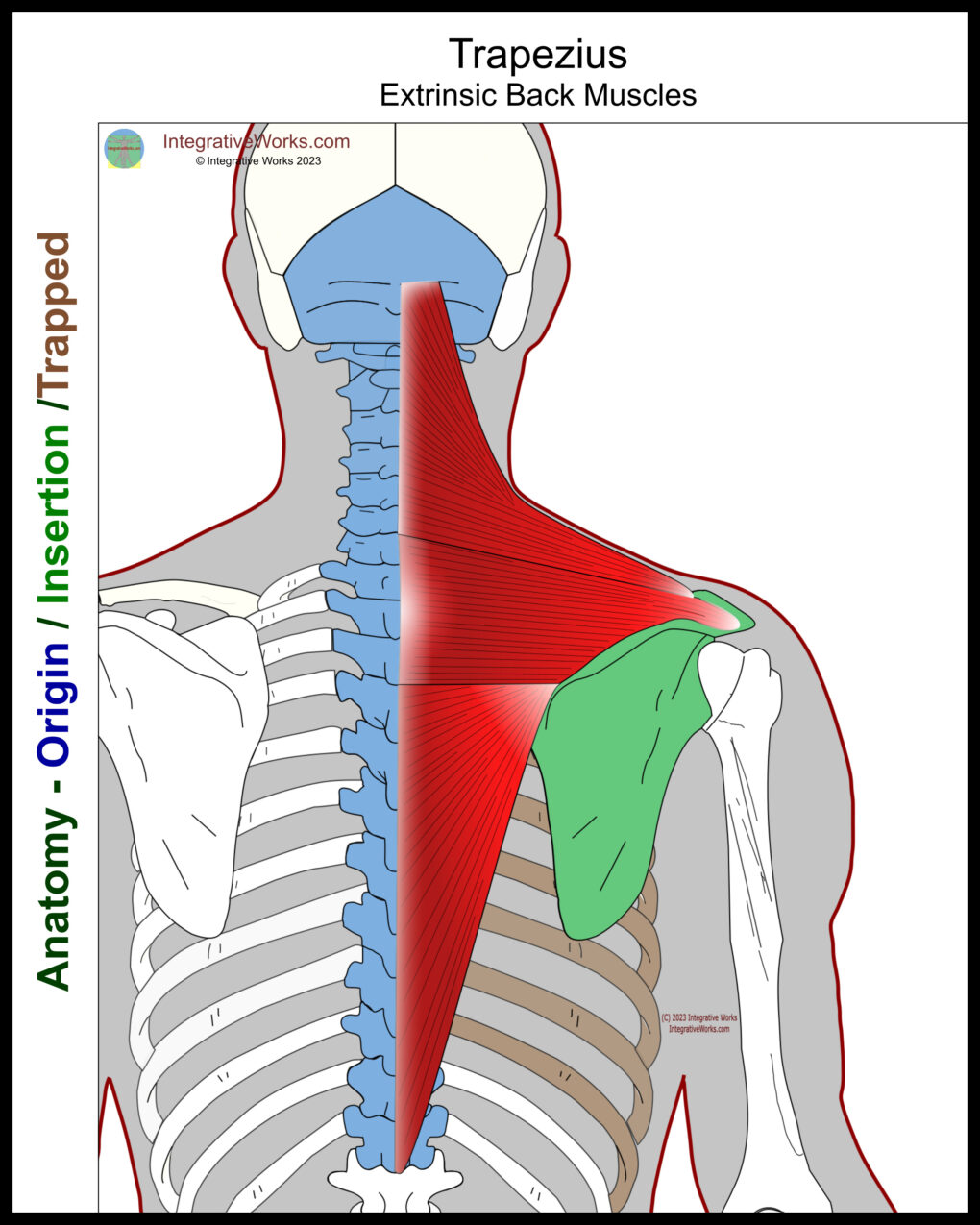
Entire Muscle
Origin
- superior nuchal line of the occiput
- nuchal ligament
- Spinous processes from the nuchal ligament to T12
Insertion
- spine of the scapula
- acromion of the scapula
- lateral third of the clavicle

Function
- retract the scapula
- upward rotation of the scapula
- elevation of the pectoral girdle
In general, the trapezius retracts the scapula. It acts to suspend and stabilize the shoulder girdle for use of the upper extremity.
It also retracts and stabilizes the scapula so that extrinsic chest muscles can expand the rib cage during labored breathing.
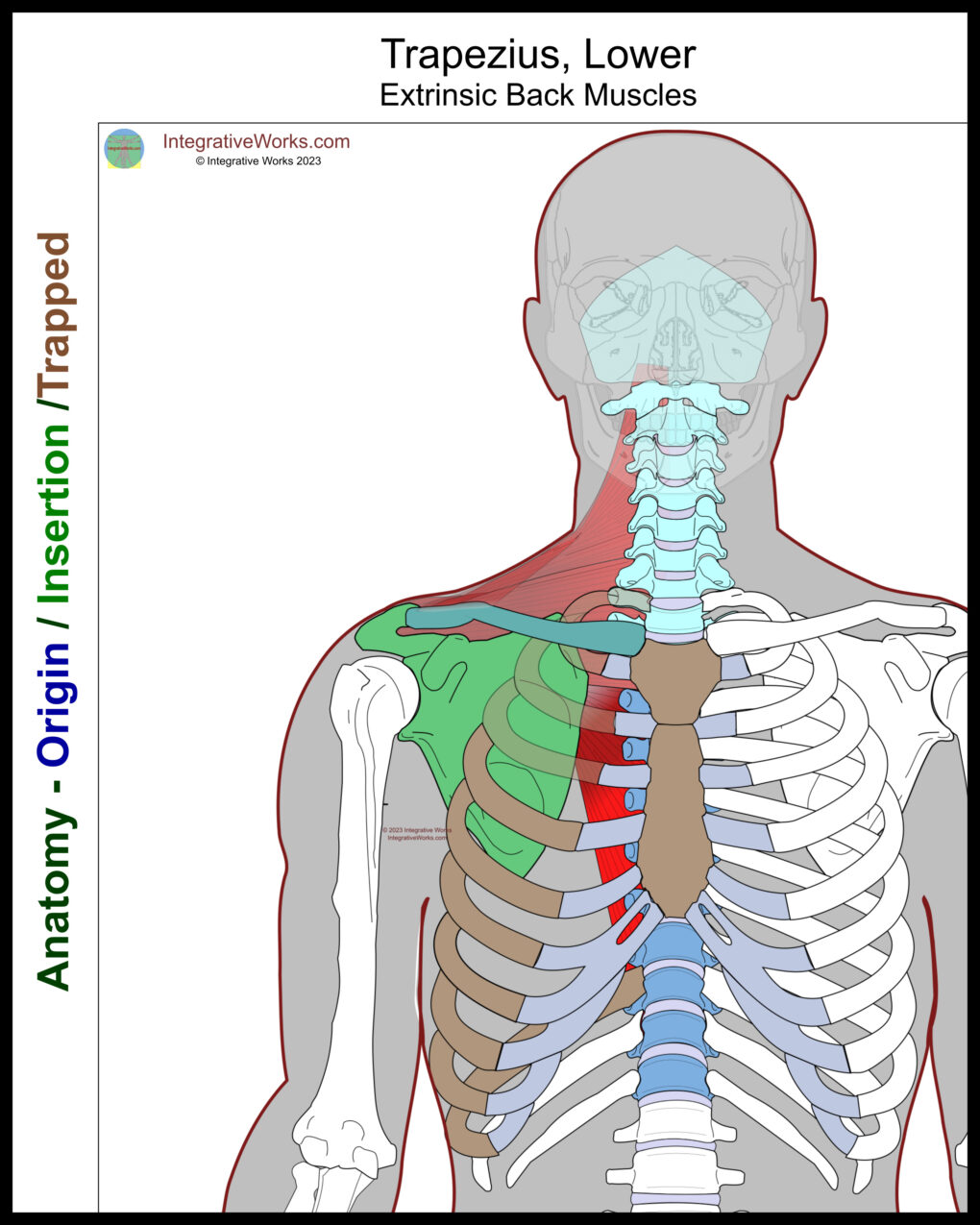
Lower Trapezius Anatomy
Origin
- the spinous processes and superior ligaments of T4-T12
Insertion
- the root of the scapula
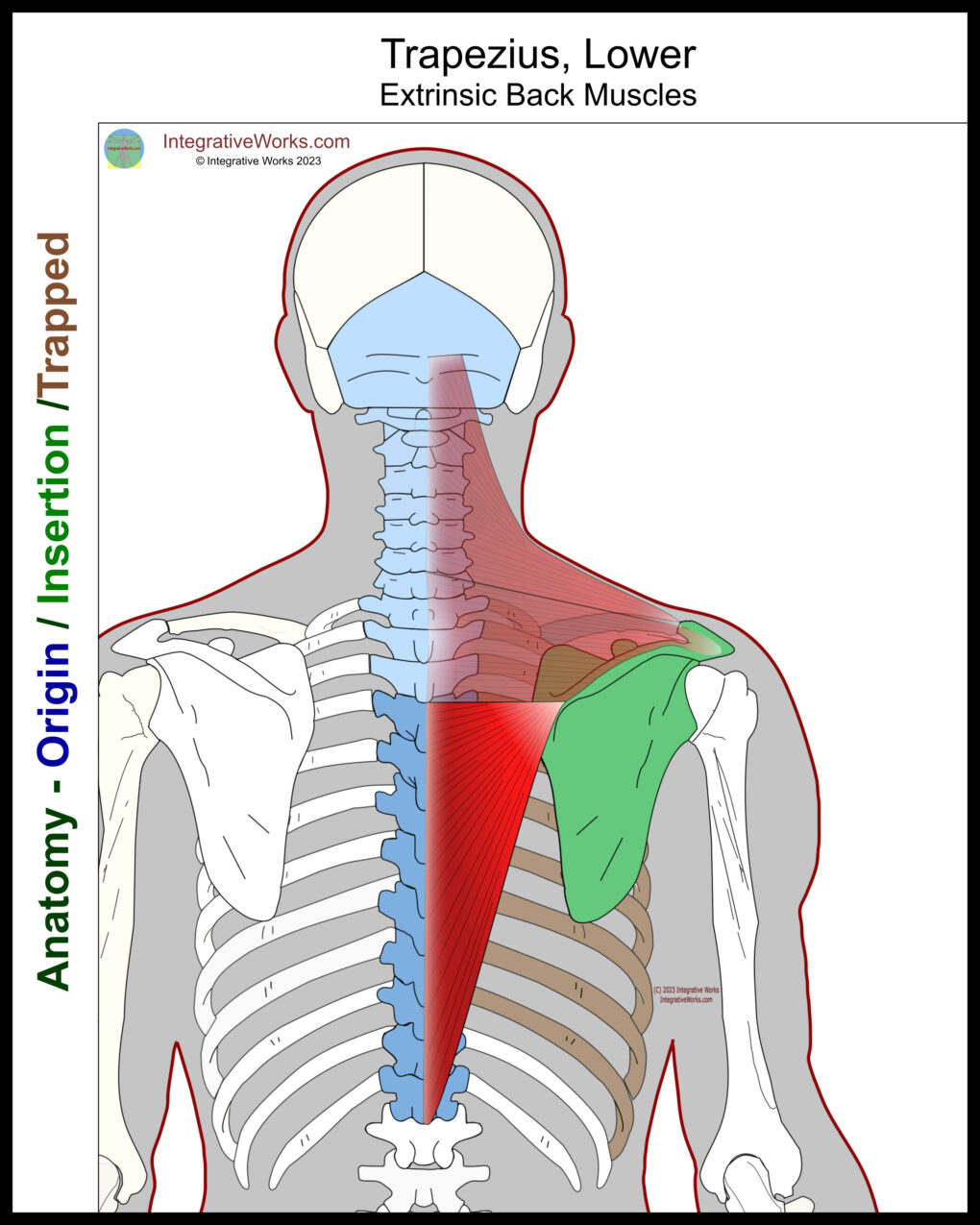
Function
- stabilize the scapula during movement of the upper extremity; may adduct or upwardly rotate the scapula
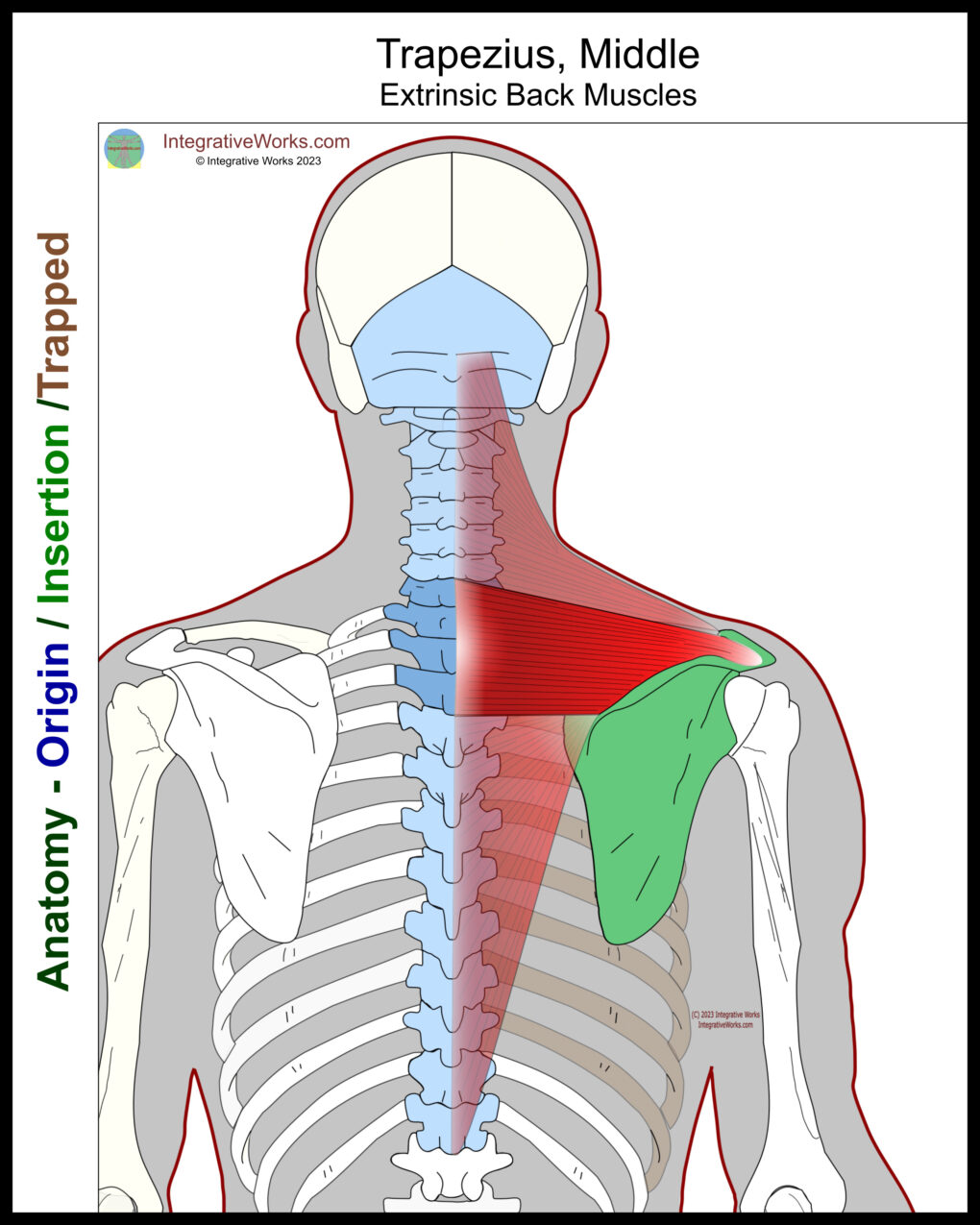
Middle Trapezius Anatomy
The middle trapezius connects the lower cervical and upper thoracic vertebrae to the scapula through the upper ribs, sternum, manubrium, and clavicle.
Origin
- the spinous processes and superior ligaments of the vertebrae C6-T3
Insertion
- acromion and spine of the scapula
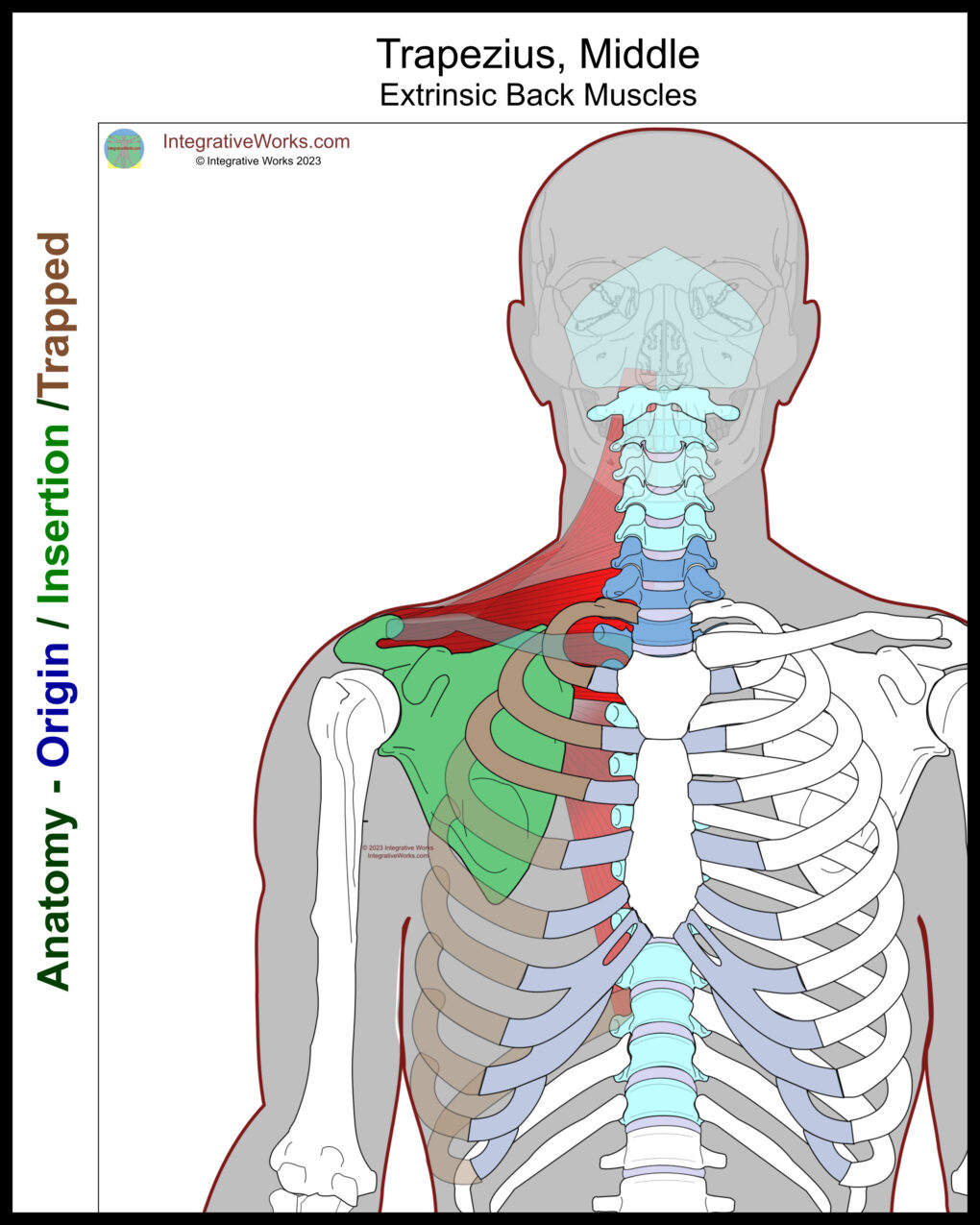
Function
- adduction of the scapula
- retraction of the scapula
- lifts the lateral angle of the scapula by pivoting the clavicle on the sternoclavicular joint.

Upper Trapezius Anatomy
The upper trapezius connects the occiput and upper cervical vertebrae to the clavicle through the lower cervical vertebrae, first rib, and manubrium.
Origin
- the medial third of the superior nuchal ridge
- ligamentum nuchae from C1-C5
Insertion
- posterior edge of the lateral clavicle
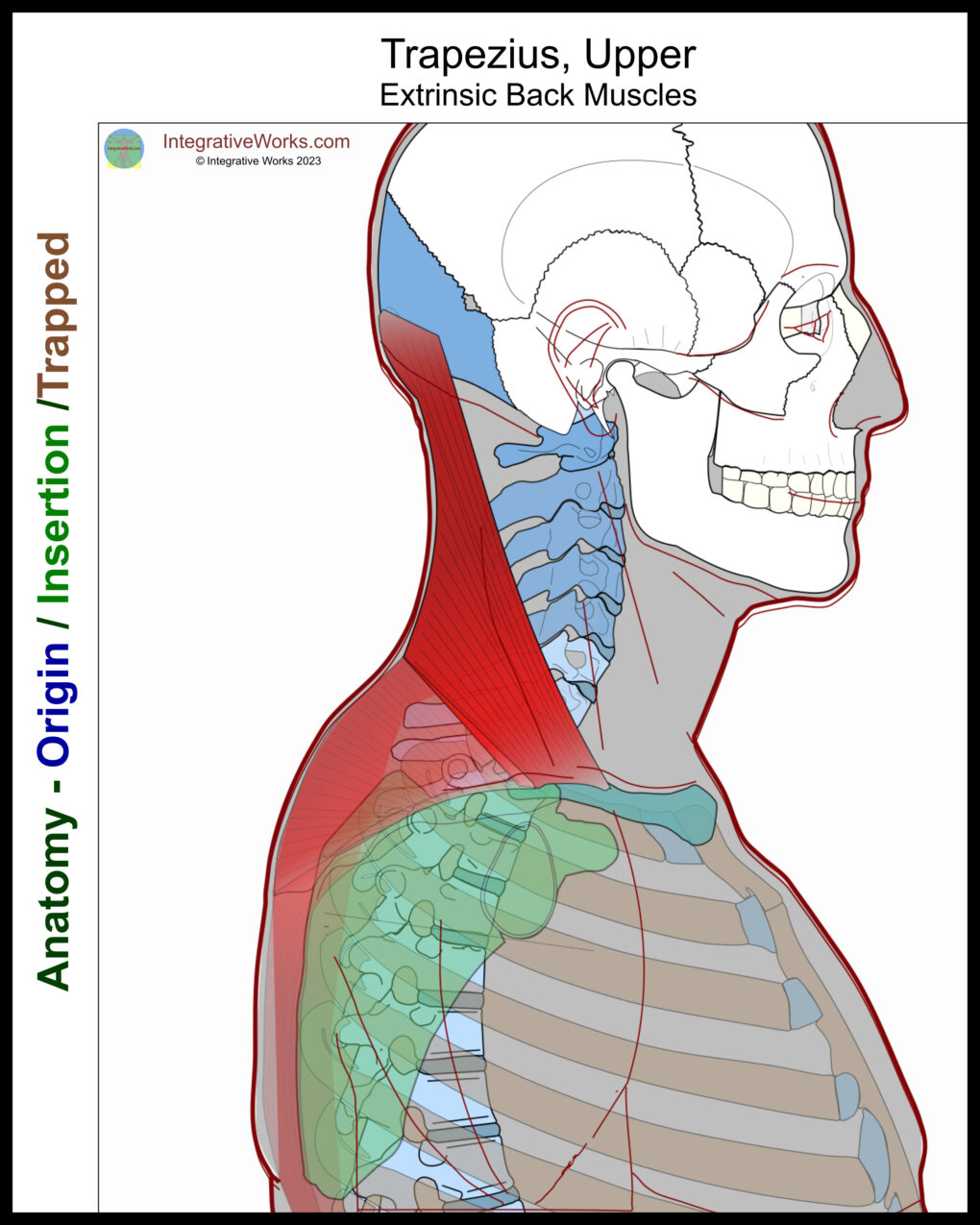
Function
- draws the lateral clavicle medially toward the spine, rotating the pectoral girdle upward as it pivots on the sternoclavicular joint
- laterally flexes the cervical vertebrae

Functional Considerations
The upper and middle trapezius help to upwardly rotate the scapula. This is primarily accomplished by pivoting the clavicle on the manubrium. The fibers of the upper trapezius are actually more lateral than vertical in direction.
The lower trapezius is in a position to retract the scapula. However, electromyographic studies show that it is not very active in retraction. Instead, it primarily acts as a stabilizer when the upper extremity is pulled forward.
From, Muscles That Influence the Spine, Barclay W. Bakkum, Gregory D. Cramer, 2014:
“Because of its size and the many locations of its attachments, the trapezius muscle also has many actions. Most of these actions result in movement of the neck and scapula (i.e., the “shoulder girdle” as a whole). The function of the trapezius muscle depends on which region of the muscle is contracting (upper, middle, or lower). The middle portion retracts the scapula, whereas the lower portion depresses the scapula and at the same time rotates the scapula so that its lateral angle moves superiorly (i.e., rotates the point of the shoulder up). The actions of the upper part of the trapezius muscle also depend on whether the head or neck or the scapula is stabilized. When moving the head and neck, the actions of the upper fibers of the trapezius muscle are also determined by whether the muscle is contracting unilaterally or bilaterally. When the head and neck are stabilized by other muscles, then there is some conflicting evidence as to whether the upper fibers of the trapezius muscle help in elevation of the scapula. Based upon information gathered from cadaveric dissections of the attachment points and directions of the upper fibers of the trapezius muscle, Johnson and colleagues (1994) concluded that these fibers do not aid in the elevation of the scapula. On the other hand, there is good electromyographic evidence that the upper fibers of the trapezius muscle are active during the elevation of the shoulder…”
Anomalies, Etc.
Clinical studies of anomalies largely focus on the absence of the trapezius unilaterally or bilaterally. As a clinician, I’ve noted that the cervical portion of the trapezius varies in its width of attachment. As well, there is an occasional additional head of the trapezius, or sternocleidomastoid between those typical heads, which attach to the clavicle.
Posts Related to the Trapezius Muscle
Burning and itching along the shoulder blade
Cervical Lamina Supine – Neuromuscular Massage Protocol
Connecting Sensory Integration and Bodywork
CranioMuscular – Superior Vertical Strain
Extrinsic Back Muscles – Functional Anatomy
Headache At Your Temple with Stiff Neck
Irritating Tags, Burning Shoulders
Lower Trapezius – – Massage Therapy Notes
Middle trapezius – Massage Therapy Notes
More than Surviving Breast Cancer.
Neck Tension When Wearing a Heavy Coat
Occipitomastoid Suture Distraction- Craniosacral Techniques
Sagittal Suture Release – Craniosacral Techniques
Self Care – Breathing Exercises to Reduce Shoulder Tension
Self Care – Burning and Itching along the Shoulder Blade
Self Care – Headache At Your Temple
Self Care – Irritating tags and Shoulder Straps
Self Care – Neck Pain with Sore Shoulder
Self Care – Neck tension when wearing a heavy coat
Sore Shoulder from Strap or Lifting Overhead
Sphenoid Decompression – Craniosacral Technique
Trapezius – Massage & Bodywork Collection
Trapezius – Neuromuscular Massage Protocol
Upper Neck Pain with Sore Top of Shoulder
Upper Trapezius – Massage Therapy Notes
Support Integrative Works to
stay independent
and produce great content.
You can subscribe to our community on Patreon. You will get links to free content and access to exclusive content not seen on this site. In addition, we will be posting anatomy illustrations, treatment notes, and sections from our manuals not found on this site. Thank you so much for being so supportive.
Cranio Cradle Cup
This mug has classic, colorful illustrations of the craniosacral system and vault hold #3. It makes a great gift and conversation piece.
Tony Preston has a practice in Atlanta, Georgia, where he sees clients. He has written materials and instructed classes since the mid-90s. This includes anatomy, trigger points, cranial, and neuromuscular.
Question? Comment? Typo?
integrativeworks@gmail.com
Follow us on Instagram

*This site is undergoing significant changes. We are reformatting and expanding the posts to make them easier to read. The result will also be more accessible and include more patterns with better self-care. Meanwhile, there may be formatting, content presentation, and readability inconsistencies. Until we get older posts updated, please excuse our mess.

